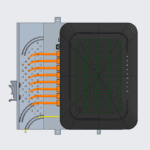DIN Rail mounting remedies problems faced by IT and networking staff in main data rooms, telecom rooms, cabinets, or other equipment enclosures. The challenges they face include the disorderly arrangement of networking components, which can lead to cable congestion, hindering accessibility and maintenance. Without standardized mounting solutions, it’s tough to ensure consistent and reliable installations, risking equipment damage and system downtime.
Tellabs DIN Rail mounting solution resolves these issues with a scalable framework that simplifies the installation and ongoing operations of Passive Optical LAN equipment. A single DIN Rail can support multiple Optical Network Terminals (ONTs), with a variety of connectivity choices, with cost-effective growth from one ONT to as many as 11 ONTs installed in a 19-inch rack space – thus, as few as two Ethernet ports to as many as 88 Ethernet ports.
This DIN Rail mounting system can be summarized into four design criteria:
 Optical LAN ONT Brackets – The Tellabs® Universal DIN Rail ONT Bracket is a mounting system used to install ONTs onto a DIN Rail. It provides standard DIN rail connectors, fiber optic cabling management, and strain relief for fiber cabling and comes in a pack of ten for installing multiple ONTs (Tellabs DIN Rail ONT Bracket package of ten: 81.11K-ONTDIN10).
Optical LAN ONT Brackets – The Tellabs® Universal DIN Rail ONT Bracket is a mounting system used to install ONTs onto a DIN Rail. It provides standard DIN rail connectors, fiber optic cabling management, and strain relief for fiber cabling and comes in a pack of ten for installing multiple ONTs (Tellabs DIN Rail ONT Bracket package of ten: 81.11K-ONTDIN10).
DIN Rail Mounting Assembly – There are many manufacturers of DIN rails in many form factors. The Tellabs solution utilizes a standard DIN rail mounting clip making it widely compatible. Using a DIN rail assembly for a 19-inch rack allows the installation of multiple ONTs side by side optimizing space usage. Other DIN rail-mounted devices can share the DIN rail with the ONTs making a clean and compact installation.
 Integrated Powering and Optical Splitter – Adding a power solution further optimizes the installation eliminating multiple power adapters. One example is the Edge Power Solutions (EPS) power supply for Optical LAN which comes equipped with 16 power outputs and can also offer 16 integrated passive optical splitter ports (e.g., 2×16 optical splitter). These one-rack unit high-powering systems can be installed directly below the DIN Rail rack assembly and provide power to each DIN rail mounted ONT (e.g., 94 watts @ 56VDC).
Integrated Powering and Optical Splitter – Adding a power solution further optimizes the installation eliminating multiple power adapters. One example is the Edge Power Solutions (EPS) power supply for Optical LAN which comes equipped with 16 power outputs and can also offer 16 integrated passive optical splitter ports (e.g., 2×16 optical splitter). These one-rack unit high-powering systems can be installed directly below the DIN Rail rack assembly and provide power to each DIN rail mounted ONT (e.g., 94 watts @ 56VDC).
ONT Connectivity Options – With all the above in place, you now can install a variety of Tellabs’ ONTs, including the Tellabs FlexSym ONT202, Tellabs FlexSym ONT205, Tellabs ONT180C, and Tellabs ONT142R. This enables the following connectivity design, performance, and capacities:
- Tellabs FlexSym ONT202: The ONT202 is fed by a symmetrical 10-gigabit XGS-PON. Each ONT202 is equipped with two multi-gigabit Ethernet ports. One DIN Rail assembly can house 10 ONT202 for supporting up to 20 multi-gigabit Ethernet (e.g., 1G, 2.5G, 5G, or 10G).
- Tellabs FlexSym ONT205: The ONT205 is connected by a symmetrical 10-gigabit XGS-PON. Each ONT205 is equipped with four multi-gigabit Ethernet ports and one multi-gigabit Ethernet port. One DIN Rail assembly can house nine ONT205 for supporting up to nine multi-gigabit Ethernet ports and 36 10/100/1000 Ethernet ports.
- Tellabs ONT180C: The ONT180C is fed by G-PON. Each ONT180C is equipped with eight gigabit Ethernet ports. One DIN Rail assembly can house 11 ONT180C for supporting up to 88 multi-gigabit Ethernet.
- Tellabs ONT142R: The ONT142R is fed by G-PON. Each ONT142R is equipped with four gigabit Ethernet, two analog voice, and one RF video port. One DIN Rail assembly can house eleven ONT142R for supporting up to 44 gigabit Ethernet, 22 analog voice, and 11 RF video ports.
The Tellabs’ DIN rail mounting solutions provide a crucial solution for network connectivity. They simplify the installation and maintenance of networking equipment, reducing clutter and ensuring optimal use of limited space. They allow for one to eleven ONTs to be mounted in a 19-inch rack space, either 10-gigabit XGS-PON or G-PON, and from two to 88 Ethernet port options. They enhance scalability and flexibility, enabling easy expansion and reconfiguration of network infrastructure, ultimately streamlining cable management and improving overall system reliability.
If you would like to learn more about Optical LAN, design, installation and operation best practices, join us online at Facebook, LinkedIn, Twitter, Instagram, and YouTube.
